Compensation stories: Netflix’s ‘personal top of market’ salaries and intense high-performance culture

🏢 Company name: Netflix
🏭 Industry: Entertainment / Video Streaming
🚀 Founded: 1997
👥 Headcount: ~14,000 employees
🌍 HQ location: Los Gatos, California, USA
💸 Compensation approach: Market-leading, location-based, flexible cash vs equity, high performance culture
Entertainment giant Netflix is well-known for its ruthlessly high-performance culture and compensation structure – pioneered by co-founder Reed Hastings with his infamous culture slide deck (now Executive Chairman).
But how competitive are salaries at Netflix in reality? How does the compensation structure align with the company’s core values? Does the approach lead to pay equity issues?
For this installment of our ‘compensation stories’ series, we’ll take a deep dive into compensation at Netflix, answering all of these questions, and many more.
Interested in more compensation strategy examples? Subscribe to our monthly newsletter to stay up-to-date with the latest.
Netflix’s values, culture, and compensation philosophy
Different companies do compensation in different ways, and the approach should be heavily influenced by the company’s culture, working practices, and business priorities.
Netflix is a great example of this – a set of core beliefs about how great outcomes are achieved defines the company’s culture and compensation philosophy.
Culture at Netflix: core principles and values
Back in 2009 co-founder and CEO Reed Hastings (now Executive Chairman of the board) presented the Netflix culture via a slide deck which has now become infamous in the tech industry.

A ruthless focus on performance is clear from this slide deck, especially through Hastings’ analogy of the Netflix team as a “professional sports team” which “focuses on performance and picking the right person for every position, even when that means swapping out someone they love for a better player.”
This effectively means that Netflix employees who don’t meet performance and business impact expectations, are quickly let go.
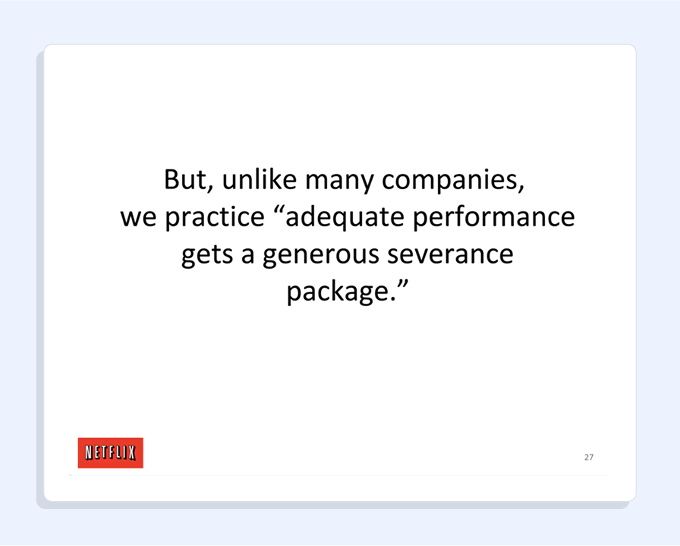
In 2024, Netflix announced an updated ‘culture memo’ published on the Netflix careers site – and whilst some tweaks and refinements have been made throughout the years, it’s clear that the quest for performance excellence and the focus on employee autonomy have remained at the heart of Netflix culture throughout the decades.
Today, Netflix has four clearly defined core principles when it comes to company culture:
- The Dream Team: We aim only to have high performers at Netflix – people who are great at what they do, and even better at working together.
- People over Process: You get better outcomes when employees have the information and freedom to make decisions for themselves. We hire unusually responsible people who thrive on this openness and freedom.
- Uncomfortably Exciting: To entertain the world, we need to be bold and ambitious. That means embracing the thrill of what’s next – even when it’s uncomfortable.
- Great and Always Better: We often say Netflix sucks today compared to where we can be tomorrow. We need the self-awareness to understand what should be better, and the discipline and resilience to get there.
Alongside those cultural principles, the company also highlights seven traits that they value in their team members:
- Selflessness
- Candour
- Judgment
- Creativity
- Inclusion
- Curiosity
- Resilience
These principles and values translate into a couple of key outcomes in terms of how work is performed at Netflix.
Firstly, Netflix has a very high bar for performance. Outstanding employees who are extremely effective at the work they do, act in the best commercial interests of the company, are constantly striving for better outcomes, and who are open to constructive feedback as part of everyday work.
Secondly, there’s a lot of autonomy and freedom at Netflix, an “almost no rules” culture where creativity, initiative, and flexibility hold significant value. This is also related to the performance culture – trusting that their exceptional team members will always make the right judgments to drive business success.
This undivided focus on excellence has been a cornerstone of Netflix’s working culture throughout the company’s growth trajectory.
How do those core principles and values manifest in Netflix’s compensation structure?
A company’s compensation structure should always be a reflection of its core values, business goals, and company culture – compensation is a vital strategic lever for driving desired behaviours and outcomes.
This is definitely true in Netflix’s case.
There are three key ways that the core principles of Netflix’s culture shine through in the company’s compensation structure:
- High performance team ➡️ Market-leading compensation packages, with very high salaries and meaningful benefits that enable employees to focus on work
- Constant pursuit of improvement ➡️ Continuous feedback approach with no formal performance / pay reviews
- Freedom and autonomy ➡️ Flexible compensation approach where employees have the choice to optimise for cash or equity
Throughout the rest of this article, we’ll take a closer look at how each of these elements of the Netflix compensation structure actually work.
Netflix’s total compensation structure
At Netflix, total compensation = salary + benefits (+ equity for some employees + performance bonuses for CEOs).
Base salaries at Netflix
At Netflix, salaries make up the bulk of employee compensation – as we’ll see later, equity is an option, and bonuses are currently only used for the co-CEOs.
Salaries are, therefore, the main compensation lever used to hire and retain the outstanding team members that are key to Netflix’s culture of excellence.
This results in base salaries that are incredibly competitive.
Netflix salaries are determined based on the ‘personal top of market’ for each employee.
“To recruit and retain stunning colleagues, we pay personal top of market for the role and location – a judgment about what that person could make in a similar role at another company, and what we would pay to keep or replace them.”
This means that Netflix uses benchmarking data to determine the highest possible salary each individual employee could receive from the companies they compete for talent with (their peer group), for that employee’s particular role, working location, experience, and skill set.
In essence, this is a market-leading approach where they pay at or above the 90th percentile to secure the best possible team members – but they do so on a case-by-case basis, rather than defining a salary band structure per role / location.
This aligns with their belief that one highly effective employee is worth the same as several average employees, as clearly outlined by Reed Hastings in a CNBC interview.
“I had a choice: hire 10 to 25 average engineers, or hire one ‘rock-star’ and pay significantly more than what I’d pay the others. Over the years, I’ve come to see that the best programmer doesn’t add 10 times the value. He or she adds more like 100 times.”
To give an indication of what a typical salary looks like, we can see from Netflix’s 2024 Proxy Statement that the median salary (non executives) in 2023 was $200,761.
Netflix’s HQ is in Los Gatos, California (the heart of Silicon Valley), and due to California’s pay transparency laws, Netflix has to disclose the salary range for all jobs advertised to be based in California – so we can use these job ads for a couple of illustrative examples.
In terms of software engineer salaries at Netflix, the company is currently hiring for a Level 4 Software Engineer in Los Gatos (as of March 2025), with an advertised salary range of $100,000-$720,000.
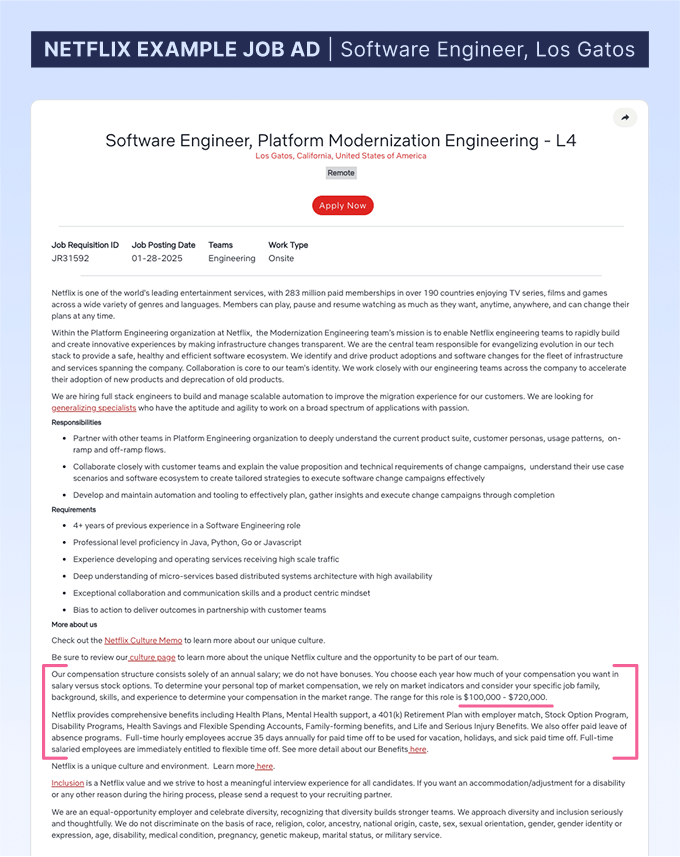
Before we look at market data for this role, it’s worth noting that we should take this salary range with a pinch of salt. It’s a very broad salary range, which means it isn’t particularly insightful. Netflix has been called out for these large ranges many times before.
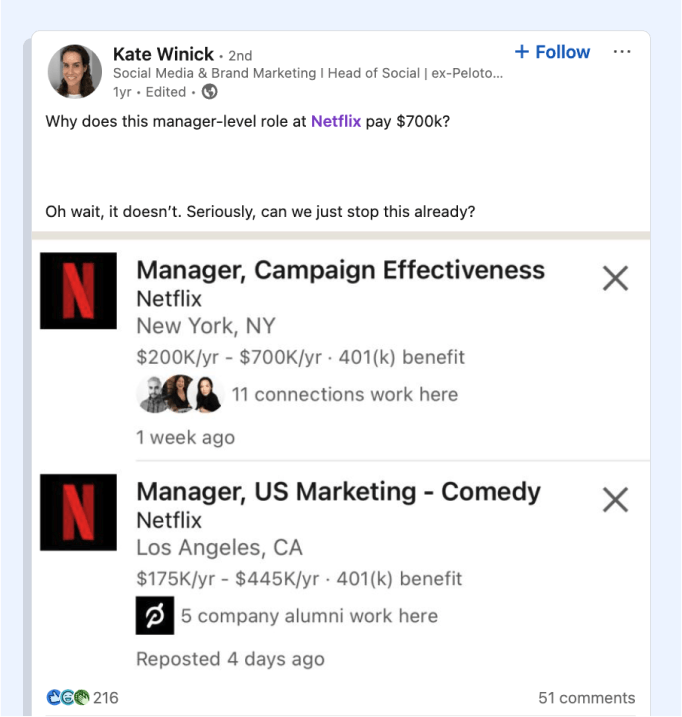
It also seems like their advertised salary range includes all job levels for that role – Netflix is also hiring for a Level 5 Software Engineer in Los Gatos, which is advertised with the same salary range of $100,000-$720,000 – so we can expect that this range reflects all of Netflix’s IC level salaries.
🕵️ Ravio POV: the problem with advertising broad salary ranges
Pay transparency laws are making it mandatory for companies to include the salary range when they advertise for a new job role. Pay equity issues, including gender pay gaps, are typically introduced during the hiring process due to discriminatory practices (including unconscious bias), including the salary negotiation process.
It’s very difficult to surface those discrepancies and prevent them from happening, without increasing transparency around salary expectations during hiring – which is why these new regulations are being implemented.
Many companies (like Netflix) have responded by advertising broad salary ranges to avoid disclosing the actual salary for specific roles at specific levels. This is far from reality, where the typical salary band width is around 15% either side of a midpoint salary.

These laws are there to enable pay equity (and there are many other benefits for the businesses too in being more transparent about compensation) but it only works when companies are open and honest about the pay for roles.
With the caveats out of the way, let’s take a look at how Ravio’s salary benchmarking data compares to Netflix’s advertised salaries – with US Tier 1 as the location (representing the highest paid locations in the US like San Francisco, New York City, and Boston) and tech as the industry.
We can see that at the 90th percentile, the market typical salary for IC level software engineers ranges from $153,900 to $326,800 – which does align with Netflix’s advertised range, despite it having a much wider minimum and maximum.
According to Levels.fyi (who regularly negotiate compensation on behalf of Netflix job candidates) recent actual salaries offered to software engineers at Netflix in Los Gatos include:
- $184,879 for an L3 Software Engineer. This is entry level at Netflix and so is equivalent to P1 or P2 in Ravio’s level framework – so it does align with our 90th percentile benchmarks of $153,900 (P1) and $191,300 (P2).
- $423,700 for an L5 Software Engineer. This is an expert level with 10+ years of experience at Netflix and so is equivalent to P5 or P6 in Ravio’s level framework – but we can see that this base salary is well above the typical 90th percentile benchmarks of $293,400 (P5) and $326,800 (P6). This suggests that Netflix salaries may be particularly market-leading for employees at higher levels of expertise, which would align with their culture of excellence.
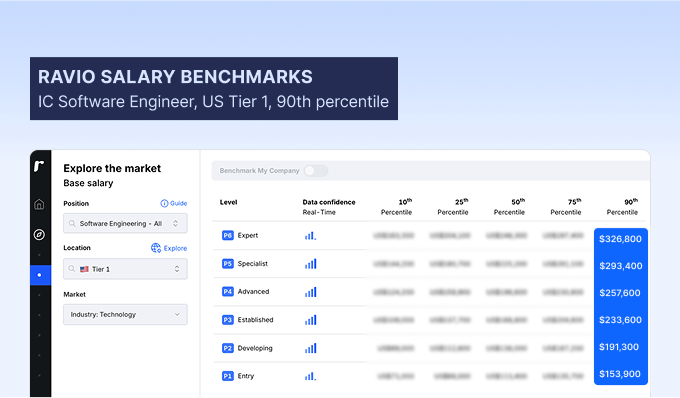
🕵️ Ravio POV: Are there problems with benchmarking salaries against a FAANG or Magnificent 7 only peer group?
As mentioned previously, one of the reasons that Netflix’s salaries are so high compared to wider market data, is that they benchmark themselves specifically against a peer group of other high paying entertainment and tech companies.
For Netflix, this makes complete sense.
They’re aiming for an incredibly high performance culture, and they use incredibly competitive salaries to attract that high performance talent, so they need to know what the highest paying salaries in the market are.
They also have the budget to pay those salaries – Netflix is one of the highest revenue companies that exists today, hence why they’re part of the ‘FAANG’ group (Facebook, Amazon, Apple, Netflix, Google).
However, we do see tech companies commonly falling into a ‘FAANG-only trap’ when they think about their own peer group for salary benchmarking, so it’s worth exploring further.
Lots of companies see themselves as high performance, and want to be able to attract talent away from FAANG companies to join their team.
To do this, they benchmark their salaries against those FAANG companies – we see this all the time at Ravio.
But the reality is that FAANG-only recruiting creates three significant business risks:
- Talent misalignment: FAANG companies operate at scales and budgets that create fundamentally different talent needs and expectations than smaller companies. Limiting talent acquisition to current FAANG employees means you’re missing hidden talent pools of employees that could be a perfect fit for your company.
- Cost inefficiency: FAANG compensation packages are designed to compete in hyper-competitive environments with massive resources, creating unsustainable cost structures for smaller companies.
- Cultural homogeneity: Drawing exclusively from similar companies creates echo chambers and limits diversity of thought and experience.
Instead, when thinking about the right peer group to aim for when salary benchmarking (and therefore which compensation data provider is the right fit), the questions companies should be asking themselves are:
- What budget do we have available for recruitment and payroll – including ongoing pay review budgets?
- What are our key talent functions and locations?
- What are our business priorities and strategic levers?
- What skillsets and roles do we need to drive those priorities?
- Where can I find the skillsets that we need?
Equity compensation at Netflix
Interestingly, at Netflix equity is not a default in employee compensation packages.
Netflix does have a stock option programme, but it’s entirely optional.
When new hires join, they choose if they want to forfeit any amount from their base salary to buy Netflix stock options instead. This opportunity is renewed every year, so employees have full choice over the proportion of cash and equity in their compensation package – this is a flexible compensation model, which is becoming an increasingly popular approach.
“Each employee chooses each year how much of their compensation they want in salary versus stock options. You can choose all cash, all options, or whatever combination suits you.”
Even more interestingly, all employee stock options are fully vested i.e. there is no waiting period before employees are able to realise the financial value of their stock options – the employee could sell the shares tomorrow if they wanted to, even if they left their job at Netflix. Employees who choose stock options over cash will see a financial upside if the market price of Netflix stock increases over time.
This is interesting because equity compensation is usually a strong component in FAANG, with companies like Google and Meta offering employees significant equity packages (stock options or RSUs) – and it’s usually used as a long-term incentive mechanism.
Equity gives employees a long-term incentive to stick with the company, through a vesting schedule that means the value of the equity increases over the employee’s tenure. Typical vesting is a 4 year vesting period with a 1 year cliff.
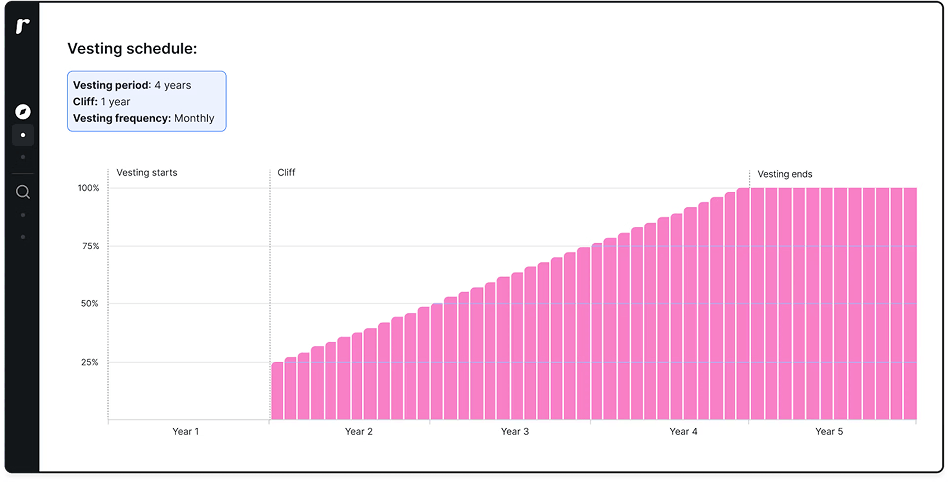
It’s also typical in FAANG companies to lean on equity refreshes to reward high performance, again increasing the long-term incentives at play.
Patty McCord, former Chief Talent Officer at Netflix, explained why they take a different approach in an interview with HBR.
“We had no vesting period – the options could be cashed in immediately. Most tech companies have a four-year vesting schedule and try to use options as “golden handcuffs” to aid retention, but we never thought that made sense. If you see a better opportunity elsewhere, you should be allowed to take what you’ve earned and leave. If you no longer want to work with us, we don’t want to hold you hostage.”
Former Chief Talent Officer at Netflix
Bonuses at Netflix
Netflix doesn’t include bonuses in employee compensation.
Presumably the reasoning is similar to why they focus less on employee equity.
They don’t want to have to incentivise team members to perform highly and to stay at Netflix for their career, they seek team members who inherently want those things – so a performance bonus or commission model wouldn’t make sense for them.
For this reason, the overall compensation structure at Netflix is unusually focused on base salary competitiveness against the market.
However, as of 2024, performance bonuses are included in executive compensation at Netflix (more on this in the executive compensation section).
Employee benefits at Netflix
Netflix offers competitive employee benefits which provide the support their team members need in order to maintain focus on delivering excellence in their career at Netflix.
“Benefits at Netflix exist to support the needs of our employees during moments that matter by offering benefits that enable every employee to sustain high performance so our employees can focus on entertaining the world.”
Benefits at Netflix are organised around four strategic pillars:
- Physical health. Ensuring all employees have the medical access they need, no matter what country they’re based in.
- Mental health. Netflix aims to “integrate wellbeing into our operations" to “sustain high performance” with benefits including free therapy and coaching, and access to mindfulness and meditation resources. Flexible working hours, and unlimited holidays with a vacation policy that reads simply ‘take vacation’ – employees are encouraged to take the time off they need to bring their best to work.
- Family. Flexible parental leave for all parents (gender-blind, including adoptive parents). Family forming benefit available to all employees (gender-blind) to support fertility, surrogacy, or adoptions.
- Financial. Retirement benefits (vary depending on employee location) support the financial future of employees. An employee giving programme also supports philanthropy, with Netflix matching any employee donations up to $20,000 per year.
The culture of freedom and autonomy shines through in Netflix’s employee benefits – employees are trusted to work the hours that suit them, and are encouraged to take time off for their wellbeing and family.
🕵️ Ravio POV: Do employees want unlimited holiday leave?
Unlimited holiday policies have become more popular over recent years, where employees do not have a set number of holiday days, but instead are able to take as much paid time off as they need throughout the year.
It sounds great in theory, but in reality many studies and experiments have found that employees typically end up taking less holiday when they have an unlimited holiday policy.
CharlieHR documented their own experience of trailing unlimited holidays for three years.
Their experience was that “a lot of people simply weren’t taking enough holiday”.
They found particularly that employees felt a lot of anxiety around their holiday allowance: “numerical limits…help to define what is acceptable behaviour”, and that it opened the door to unfairness, as some employees took lots of holiday days and left other team members to pick up the slack.
With Netflix’s inherently high-performance culture, these issues could be heightened even more.
Looking at Ravio’s data, we can see that unlimited holiday policies are very much still the exception – but, in the US 45% of companies do offer unlimited leave.
In Europe, the Netherlands is the highest adopter, where 19% of companies offer unlimited holidays. In the UK, 15% of companies offer unlimited holiday days. In Germany it’s 7% of companies, in France just 1%.

Executive salaries at Netflix
Netflix’s executive team are compensated through base salary, stock options, and the standard employee benefits.
The co-CEOs of Netflix also now receive a performance bonus each year.
This performance bonus mechanism was introduced by Netflix’s board in 2023, due to concerns raised about the very high salaries of the co-CEOs at the time.
So, from 2023 onwards, the base salary for Netflix CEOs was capped at $3 million per year and a bonus was introduced with a target of $6 million to be determined based on company performance.
In reality, if we look at the figures for 2023 in Netflix’s 2024 proxy statement, we can see that this shift actually resulted in very little change in terms of total compensation.
In 2022, CEO Ted Sarandos had a base salary of $20 million, stock options worth $28 million, and ‘other compensation’ of $1.7 million dollars – totalling $50.2 in total compensation.
In 2023, Sarandos received a base salary of $3 million, stock options work $28 million, a performance bonus of $16.5 million (way above the target of $6 million), and ‘other compensation’ of $2 million (which includes home security costs, use of company aircraft, and more) – totalling $49.8 in total compensation.
Effectively, the salary reduction was simply shifted to a bonus instead, but we may see this shift in future years as these changes are cemented.
To put executive pay at Netflix into context, the median employee rewards (non executive) at Netflix in 2023 was $200,761. This puts the ratio of Sarandos’ compensation to the median employee at 248:1.

Salary reviews and career progression at Netflix
There is no formal performance and compensation review process at Netflix today.
Instead, as we saw earlier, continuous feedback is deeply embedded within the company’s high-performance culture, with 360 degree feedback constantly being shared between team members.
As former Netflix Chief Talent Officer, Patty McCord put it in his interview with HBR:
“HR people can’t believe that a company the size of Netflix doesn’t hold annual reviews. “Are you making this up just to upset us?” they ask. I’m not. If you talk simply and honestly about performance on a regular basis, you can get good results – probably better ones than a company that grades everyone on a five-point scale.”
Former Chief Talent Officer at Netflix
Performance at Netflix is measured based on business impacts – if you’re doing the best of your ability, thinking creatively, taking risks, and bringing Netflix forward, then you’re performing highly. There’s no set of KPIs or formal measurements.
One key tenet of the feedback culture at Netflix is the keeper test.
The keeper test is a method of assessing employee performance where their line manager considers the question ‘If X wanted to leave today, would I fight to keep them?’
This method has often been criticised for being a brutal way to communicate performance with employees, but for some Netflix employees it seems to be a positive – it means there are no surprises, because an open dialogue is always there in terms of where your performance stands, how you could progress, and where you might need to step it up.
“We expect leaders to be strong developers of talent. And to ensure they have the right player at every position, we ask them to apply what we call the “keeper test” — asking “if X wanted to leave, would I fight to keep them?” If the answer is no, we believe it’s fairer to everyone to part ways quickly.”
🕵️ Ravio POV: One-off performance reviews vs continuous 360 feedback
Pay for performance models, where annual pay rises are determined (partly or wholly) based on the outcomes of an annual performance review, can be an effective way to incentivise employee performance and drive progress towards business goals.
However, when performance reviews are a one-off annual activity, this can cause problems. It can become a very competitive process (especially if it’s known that there is a limited merit pool) where short-term thinking is encouraged to meet defined performance targets. It can also become a very stressful process for employees and managers alike.
When we spoke with Rewards experts Rob Green and Figen Zaim about the pros and cons of pay for performance, they both highlighted the need to avoid surprises when rewarding employee performance.
For Rob: “There’s nothing worse than surprises, as employees lose confidence and trust in the process and leadership.”
And as Figen put it: “The worst thing you can do is to wait for a whole year, and then tell an employee that they’re way off where they need to be to receive a pay increase or promotion – don’t wait to give feedback (whether positive or negative) until the allotted time, do it now”.
For them, a robust system of regular feedback and performance discussions is key – so this approach by Netflix of continuous feedback and performance monitoring, does align with their experience and expertise.
In terms of pay increases, there is also no formal pay review process.
Instead, this continuous feedback is used to inform changes needed in terms of employee progression and promotions.
Due to Netflix’s focus on highly competitive salaries compared to the market, the team also constantly monitors the market (including using Ravio’s real-time compensation benchmarking data) to understand whether the market is shifting.
If the market does change, then market adjustments will be made accordingly to increase employee salaries.
This approach ensures competitiveness is maintained, avoiding retention issues if more competitive salaries are being offered elsewhere.
At the same time, it also supports Netflix’s pay equity goals (see next section for more on this) by focusing on market adjustments rather than subjective performance and pay reviews.
“We do not think of these as “raises” and there is no raise pool to divide up. The market for talent is what it is and is not defined by set bands and grades. If your market adjusts, we do not have to wait for an annual compensation event to make changes. We hope through this compensation approach, we can dismantle pay disparities across gender and race.”
🕵️ Ravio POV: How performance-driven pay reviews can damage pay equity – and how to mitigate this
Performance reviews always hold a level of subjectivity and bias, which can damage pay equity.
For instance, visibility bias impacts women more than men as they are both more likely to have time off for parental leave and more likely to prefer remote working for greater flexibility. Further, men are also typically the most likely to ask for a salary increase themselves – those who shout the loudest often end up being the ones rewarded.
Therefore, Netflix’s consideration of pay equity in terms of pay reviews is a great point and one that all Rewards teams should be aware of – it’s also why highly transparent companies like Buffer are foregoing salary negotiation within the hiring process.
There are ways to control the level of subjectivity involved, such as:
- Clear rationale behind why performance is rewarded and how this aligns with the company’s compensation philosophy and culture
- Clear factors for how performance is measured that are as objective and quantifiable as possible
- Manager training on unconscious bias during performance and pay reviews, and how to avoid it
- Well-structured and facilitated calibration meetings that seek alignment across the management team
- Pay equity analysis before decisions are finalised to understand the before and after impacts
- Strong employee communication on the process and on their own performance and feedback.
Netflix’s gender pay gap
Netflix’s 2024 ESG report suggests that Netflix has a very small gender pay gap overall, citing ‘adjusted pay equity’ of women earning 99 cents for every dollar that men do.
Gender pay gaps are normally expressed in a percentage, so this would equate to a 1% adjusted gender pay gap at Netflix.
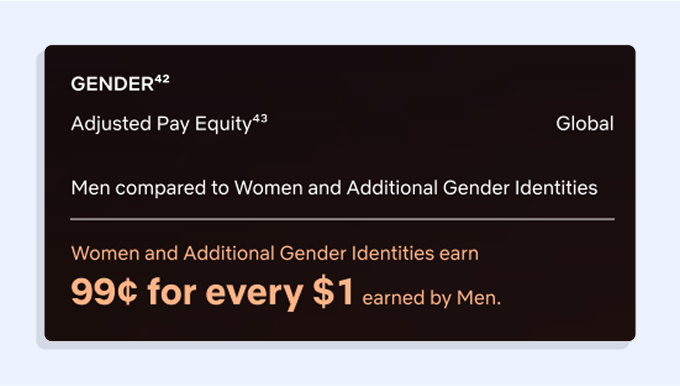
This is very low compared to the standard – according to Ravio’s pay equity data, the overall adjusted gender pay gap in Europe is 2.5%.
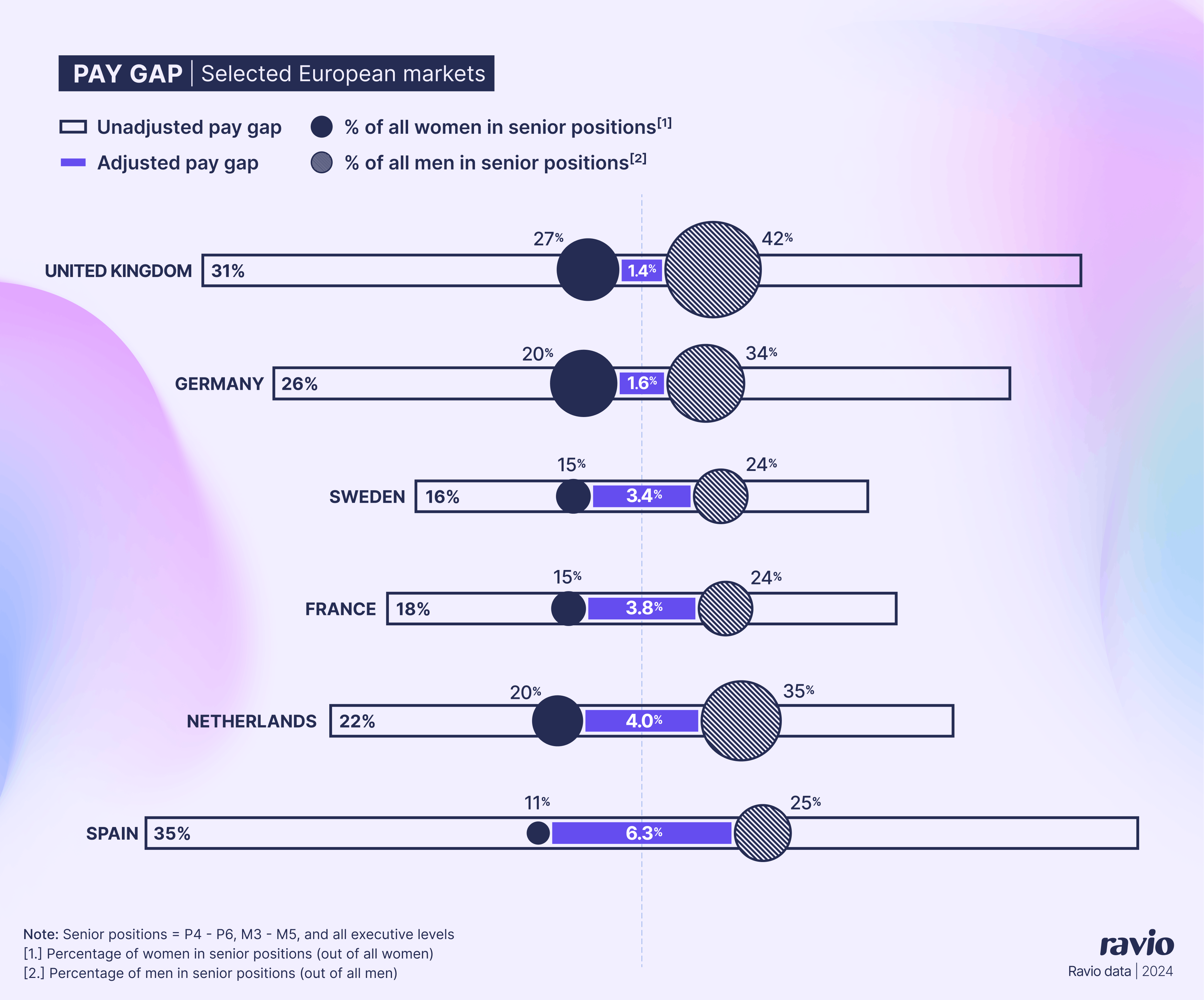
This is likely driven by the representation of women in Netflix.
According to the 2024 ESG report, 51.6% of all Netflix employees globally identify as women. For Director-level roles, 52.4% of Netflix employees identify as women – which is very unusual. The number does decrease at ‘Senior Leadership’ level, with only 8 out of 22 executives women – 36.4%.

Compared to the overall average based on Ravio’s pay equity data, we can see that Netflix has above average representation of women both across the board and at senior levels.
The average company is made up of 41% women overall, and only 21% women at the executive level.

However, whilst the commitment is commendable, it’s important to note that Netflix’s pay equity reporting is fairly top level.
There’s no breakdown across all specific job levels or job roles – and in large tech companies we typically see a huge difference in the representation of women and the gender pay gap in tech roles.
“We conduct pay equity analyses at least once a year to ensure compensation is on par across similar work in the same location, with similar skills and levels of performance.”
In their ESG report, Netflix also cites the importance of their inclusive hiring practices and early careers programmes.
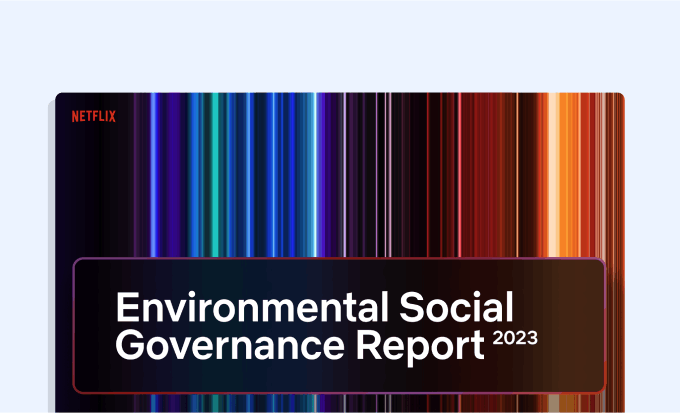
In terms of inclusive hiring, this includes:
- Inclusive candidate sourcing through recruiting events and job boards outside of the norm – including organisations such as AfroTech, ADCOLOR, Latinas Rising Up in HR, The LGBTQ+ Bar, and Perspektywy Women in Tech.
- Reducing bias through a consistent and positive interview process.
In terms of early career programmes, this includes:
- Internship and graduate programmes in place since 2020 to build more diverse pipelines in tech overall. 247 students (113 interns and 134 graduates) were hired through these programmes in 2023, with 45% of them women.
- A Pathways Program which connects underrepresented students with training and mentorship opportunities to prepare them for entry level roles in the tech space.
🕵️ Ravio POV: Is this focus on hiring processes and early career support the right way to improve the representation of women in tech?
The analysis for our 2024 Pay Equity Report identified that the low representation of women in senior leadership positions is the single biggest reason for the gender pay gap in tech.
In fact, when this is accounted for through calculating the adjusted gender pay gap, the gap drops to 2.5% (from 25% unadjusted).
Hiring is absolutely a huge factor in this.
In fact, our analysis identified that the gender pay gap is already present in starting salaries, and that there is no significant difference in annual pay increases and promotion rates between men and women.
For instance, for P4 Software Engineers in the UK we found that the median new hire salary for men is £85,000 whereas for women it is £82,288 – a pay gap of 3.3% for starting salaries.

In contrast, the analysis found no statistically significant difference in promotion rates or promotion pay increases between men and women.

We also know that less women apply for roles in tech in the first place, damaging the representation of women in tech.
Therefore, Netflix’s commitment to improving hiring processes and supporting early career diversity programmes, are a great example to follow to work towards a more diverse tech workforce.